Solar eclipse of April 29, 2014
An annular solar eclipse occurred at the Moon's descending node of orbit on Tuesday, April 29, 2014,[1][2] with a magnitude of 0.9868. A solar eclipse occurs when the Moon passes between Earth and the Sun, thereby totally or partly obscuring the image of the Sun for a viewer on Earth. An annular solar eclipse occurs when the Moon's apparent diameter is smaller than the Sun's, blocking most of the Sun's light and causing the Sun to look like an annulus (ring). An annular eclipse appears as a partial eclipse over a region of the Earth thousands of kilometres wide. The Moon's apparent diameter was near the average diameter because it occurred 6.2 days after perigee (on April 23, 2014, at 1:20 UTC) and 7.2 days before apogee (on May 6, 2014, at 11:20 UTC).[3]
This eclipse's gamma value was closer to 1 than any other eclipse from 2000 B.C. to 3000 A.D. This means the center of the Moon's shadow passed almost exactly at the surface of the Earth, barely missing the Antarctic continent by a few kilometers.
The center of the Moon's shadow missed the Earth's South Pole, but an annular eclipse was visible from a small part of Antarctica, and a partial eclipse was visible from parts of Antarctica and Australia.
Visibility
Animation of eclipse path
Images
-
 Simulated annularity from Victoria Land
Simulated annularity from Victoria Land -
 Partial from Scarborough, Queensland, 7:03 UTC
Partial from Scarborough, Queensland, 7:03 UTC -
 Partial from Lake Wendouree, Victoria, 7:04 UTC
Partial from Lake Wendouree, Victoria, 7:04 UTC
Eclipse details
Shown below are two tables displaying details about this particular solar eclipse. The first table outlines times at which the moon's penumbra or umbra attains the specific parameter, and the second table describes various other parameters pertaining to this eclipse.[4]
| Event | Time (UTC) |
|---|---|
| First Penumbral External Contact | 2014 April 29 at 03:53:46.0 UTC |
| Equatorial Conjunction | 2014 April 29 at 05:38:58.2 UTC |
| First Umbral External Contact | 2014 April 29 at 05:58:45.6 UTC |
| Greatest Eclipse | 2014 April 29 at 06:04:32.9 UTC |
| Last Umbral Internal Contact | 2014 April 29 at 06:10:41.3 UTC |
| Ecliptic Conjunction | 2014 April 29 at 06:15:28.3 UTC |
| Last Penumbral External Contact | 2014 April 29 at 08:15:37.1 UTC |
| Parameter | Value |
|---|---|
| Eclipse Magnitude | 0.98679 |
| Eclipse Obscuration | - |
| Gamma | -0.99996 |
| Sun Right Ascension | 02h25m52.9s |
| Sun Declination | +14°26'54.2" |
| Sun Semi-Diameter | 15'52.9" |
| Sun Equatorial Horizontal Parallax | 08.7" |
| Moon Right Ascension | 02h26m46.0s |
| Moon Declination | +13°31'06.8" |
| Moon Semi-Diameter | 15'38.4" |
| Moon Equatorial Horizontal Parallax | 0°57'24.1" |
| ΔT | 67.3 s |
Eclipse season
This eclipse is part of an eclipse season, a period, roughly every six months, when eclipses occur. Only two (or occasionally three) eclipse seasons occur each year, and each season lasts about 35 days and repeats just short of six months (173 days) later; thus two full eclipse seasons always occur each year. Either two or three eclipses happen each eclipse season. In the sequence below, each eclipse is separated by a fortnight.
| April 15 Ascending node (full moon) | April 29 Descending node (new moon) |
|---|---|
 |  |
| Total lunar eclipse Lunar Saros 122 | Annular solar eclipse Solar Saros 148 |
Related eclipses
Eclipses in 2014
- A total lunar eclipse on April 15.
- An annular solar eclipse on April 29.
- A total lunar eclipse on October 8.
- A partial solar eclipse on October 23.
Metonic
- Preceded by: Solar eclipse of July 11, 2010
- Followed by: Solar eclipse of February 15, 2018
Tzolkinex
- Preceded by: Solar eclipse of March 19, 2007
- Followed by: Solar eclipse of June 10, 2021
Half-Saros
- Preceded by: Lunar eclipse of April 24, 2005
- Followed by: Lunar eclipse of May 5, 2023
Tritos
- Preceded by: Solar eclipse of May 31, 2003
- Followed by: Solar eclipse of March 29, 2025
Solar Saros 148
- Preceded by: Solar eclipse of April 17, 1996
- Followed by: Solar eclipse of May 9, 2032
Inex
- Preceded by: Solar eclipse of May 19, 1985
- Followed by: Solar eclipse of April 9, 2043
Triad
- Preceded by: Solar eclipse of June 29, 1927
- Followed by: Solar eclipse of February 28, 2101
Solar eclipses of 2011–2014
This eclipse is a member of a semester series. An eclipse in a semester series of solar eclipses repeats approximately every 177 days and 4 hours (a semester) at alternating nodes of the Moon's orbit.[5]
The partial solar eclipses on January 4, 2011 and July 1, 2011 occur in the previous lunar year eclipse set.
| Solar eclipse series sets from 2011 to 2014 | ||||||
|---|---|---|---|---|---|---|
| Descending node | Ascending node | |||||
| Saros | Map | Gamma | Saros | Map | Gamma | |
118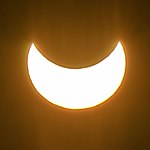 Partial in Tromsø, Norway | June 1, 2011 Partial | 1.21300 | 123 Hinode XRT footage | November 25, 2011 Partial | −1.05359 | |
128 Annularity in Red Bluff, CA, USA | May 20, 2012 Annular | 0.48279 | 133 Totality in Mount Carbine, Queensland, Australia | November 13, 2012 Total | −0.37189 | |
138 Annularity in Churchills Head, Australia | May 10, 2013 Annular | −0.26937 | 143 Partial in Libreville, Gabon | November 3, 2013 Hybrid | 0.32715 | |
148 Partial in Adelaide, Australia | April 29, 2014 Annular (non-central) | −0.99996 | 153 Partial in Minneapolis, MN, USA | October 23, 2014 Partial | 1.09078 | |
Saros 148
This eclipse is a part of Saros series 148, repeating every 18 years, 11 days, and containing 75 events. The series started with a partial solar eclipse on September 21, 1653. It contains annular eclipses on April 29, 2014 and May 9, 2032; a hybrid eclipse on May 20, 2050; and total eclipses from May 31, 2068 through August 3, 2771. The series ends at member 75 as a partial eclipse on December 12, 2987. Its eclipses are tabulated in three columns; every third eclipse in the same column is one exeligmos apart, so they all cast shadows over approximately the same parts of the Earth.
The longest duration of annularity will be produced by member 22 at 22 seconds (by default) on May 9, 2032, and the longest duration of totality will be produced by member 54 at 5 minutes, 23 seconds on April 26, 2609. All eclipses in this series occur at the Moon’s descending node of orbit.[6]
| Series members 10–31 occur between 1801 and 2200: | ||
|---|---|---|
| 10 | 11 | 12 |
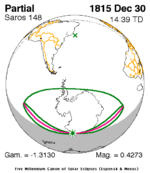 December 30, 1815 |  January 9, 1834 |  January 21, 1852 |
| 13 | 14 | 15 |
 January 31, 1870 |  February 11, 1888 |  February 23, 1906 |
| 16 | 17 | 18 |
 March 5, 1924 |  March 16, 1942 |  March 27, 1960 |
| 19 | 20 | 21 |
 April 7, 1978 |  April 17, 1996 |  April 29, 2014 |
| 22 | 23 | 24 |
 May 9, 2032 |  May 20, 2050 |  May 31, 2068 |
| 25 | 26 | 27 |
 June 11, 2086 |  June 22, 2104 |  July 4, 2122 |
| 28 | 29 | 30 |
 July 14, 2140 | 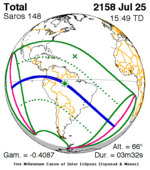 July 25, 2158 |  August 4, 2176 |
| 31 | ||
 August 16, 2194 | ||
Metonic series
The metonic series repeats eclipses every 19 years (6939.69 days), lasting about 5 cycles. Eclipses occur in nearly the same calendar date. In addition, the octon subseries repeats 1/5 of that or every 3.8 years (1387.94 days). All eclipses in this table occur at the Moon's descending node.
| 21 eclipse events between July 11, 1953 and July 11, 2029 | ||||
|---|---|---|---|---|
| July 10–11 | April 29–30 | February 15–16 | December 4 | September 21–23 |
| 116 | 118 | 120 | 122 | 124 |
 July 11, 1953 |  April 30, 1957 |  February 15, 1961 |  December 4, 1964 |  September 22, 1968 |
| 126 | 128 | 130 | 132 | 134 |
 July 10, 1972 |  April 29, 1976 |  February 16, 1980 |  December 4, 1983 |  September 23, 1987 |
| 136 | 138 | 140 | 142 | 144 |
 July 11, 1991 |  April 29, 1995 |  February 16, 1999 |  December 4, 2002 |  September 22, 2006 |
| 146 | 148 | 150 | 152 | 154 |
 July 11, 2010 |  April 29, 2014 |  February 15, 2018 |  December 4, 2021 |  September 21, 2025 |
| 156 | ||||
 July 11, 2029 | ||||
Tritos series
This eclipse is a part of a tritos cycle, repeating at alternating nodes every 135 synodic months (≈ 3986.63 days, or 11 years minus 1 month). Their appearance and longitude are irregular due to a lack of synchronization with the anomalistic month (period of perigee), but groupings of 3 tritos cycles (≈ 33 years minus 3 months) come close (≈ 434.044 anomalistic months), so eclipses are similar in these groupings.
The partial solar eclipses on December 18, 2188 (part of Saros 164) and November 18, 2199 (part of Saros 165) are also a part of this series but are not included in the table below.
| Series members between 1801 and 2134 | ||||
|---|---|---|---|---|
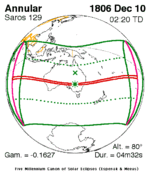 December 10, 1806 (Saros 129) |  November 9, 1817 (Saros 130) |  October 9, 1828 (Saros 131) |  September 7, 1839 (Saros 132) |  August 7, 1850 (Saros 133) |
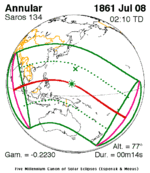 July 8, 1861 (Saros 134) | 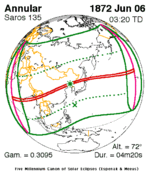 June 6, 1872 (Saros 135) |  May 6, 1883 (Saros 136) |  April 6, 1894 (Saros 137) |  March 6, 1905 (Saros 138) |
 February 3, 1916 (Saros 139) |  January 3, 1927 (Saros 140) |  December 2, 1937 (Saros 141) |  November 1, 1948 (Saros 142) |  October 2, 1959 (Saros 143) |
 August 31, 1970 (Saros 144) |  July 31, 1981 (Saros 145) |  June 30, 1992 (Saros 146) |  May 31, 2003 (Saros 147) |  April 29, 2014 (Saros 148) |
 March 29, 2025 (Saros 149) |  February 27, 2036 (Saros 150) |  January 26, 2047 (Saros 151) |  December 26, 2057 (Saros 152) |  November 24, 2068 (Saros 153) |
 October 24, 2079 (Saros 154) |  September 23, 2090 (Saros 155) |  August 24, 2101 (Saros 156) |  July 23, 2112 (Saros 157) |  June 23, 2123 (Saros 158) |
 May 23, 2134 (Saros 159) | ||||
Inex series
This eclipse is a part of the long period inex cycle, repeating at alternating nodes, every 358 synodic months (≈ 10,571.95 days, or 29 years minus 20 days). Their appearance and longitude are irregular due to a lack of synchronization with the anomalistic month (period of perigee). However, groupings of 3 inex cycles (≈ 87 years minus 2 months) comes close (≈ 1,151.02 anomalistic months), so eclipses are similar in these groupings.
| Series members between 1801 and 2200 | ||
|---|---|---|
 September 17, 1811 (Saros 141) |  August 27, 1840 (Saros 142) |  August 7, 1869 (Saros 143) |
 July 18, 1898 (Saros 144) |  June 29, 1927 (Saros 145) |  June 8, 1956 (Saros 146) |
 May 19, 1985 (Saros 147) |  April 29, 2014 (Saros 148) |  April 9, 2043 (Saros 149) |
 March 19, 2072 (Saros 150) | 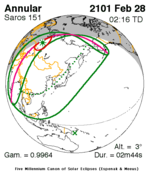 February 28, 2101 (Saros 151) |  February 8, 2130 (Saros 152) |
 January 19, 2159 (Saros 153) |  December 29, 2187 (Saros 154) | |
Notes
References
- ^ "April 29, 2014 Annular Solar Eclipse". timeanddate. Retrieved 12 August 2024.
- ^ "Antarctic prime spot for Tuesday's solar eclipse". The Brownsville Herald. 2014-04-30. p. 21. Retrieved 2023-10-26 – via Newspapers.com.
- ^ "Moon Distances for London, United Kingdom, England". timeanddate. Retrieved 12 August 2024.
- ^ "Annular Solar Eclipse of 2014 Apr 29". EclipseWise.com. Retrieved 12 August 2024.
- ^ van Gent, R.H. "Solar- and Lunar-Eclipse Predictions from Antiquity to the Present". A Catalogue of Eclipse Cycles. Utrecht University. Retrieved 6 October 2018.
- ^ "NASA - Catalog of Solar Eclipses of Saros 148". eclipse.gsfc.nasa.gov.
External links

- Earth visibility chart and eclipse statistics Eclipse Predictions by Fred Espenak, NASA/GSFC
- Google interactive map
- Besselian elements
- A Partially Eclipsed Setting Sun, APOD 4/30/2014, partial eclipse of Adelaide, South Australia
- Brisbane Sunset Moonset, APOD 5/1/2014, partial eclipse of Brisbane, Queensland
- v
- t
- e
| By era | |
|---|---|
| Saros series (list) | |
| Visibility | |
| Historical |
|

Total/hybrid eclipses
→ next total/hybrid
- 1133
- 1185
- 1560
- 1598
- 1652
- 1654
- 1673
- 1706
- 1715
- 1724
- 1766
- 1778
- 1780
- 1806
- 1816
- 1824
- 1842
- 1851
- 1853
- 1857
- 1858
- 1860
- 1865
- 1867
- 1868
- 1869
- 1870
- 1871
- 1874
- 1875
- 1878
- 1882
- 1883
- 1885
- 1886
- 1887
- Jan. 1889
- Dec. 1889
- 1893
- 1896
- 1898
- 1900
- 1901
- 1903
- 1904
- 1905
- 1907
- Jan. 1908
- Dec. 1908
- 1909
- 1910
- 1911
- Apr. 1912
- Oct. 1912
- 1914
- 1916
- 1918
- 1919
- 1921
- 1922
- 1923
- 1925
- 1926
- 1927
- 1928
- 1929
- Apr. 1930
- Oct. 1930
- 1932
- 1934
- 1936
- 1937
- 1938
- 1939
- 1940
- 1941
- 1943
- Jan. 1944
- 1945
- 1947
- 1948
- 1950
- 1952
- 1954
- 1955
- 1956
- 1957
- 1958
- 1959
- 1961
- 1962
- 1963
- 1965
- 1966
- 1967
- 1968
- 1970
- 1972
- 1973
- 1974
- 1976
- 1977
- 1979
- 1980
- 1981
- 1983
- 1984
- 1985
- 1986
- 1987
- 1988
- 1990
- 1991
- 1992
- 1994
- 1995
- 1997
- 1998
- 1999
- 2001
- 2002
- 2003
- 2005
- 2006
- 2008
- 2009
- 2010
- 2012
- 2013
- 2015
- 2016
- 2017
- 2019
- 2020
- 2021
- 2023
- 2024
- → 2026
- 2027
- 2028
- 2030
- 2031
- 2033
- 2034
- 2035
- 2037
- 2038
- 2039
- 2041
- 2042
- 2043
- 2044
- 2045
- 2046
- 2048
- 2049
- 2050
- 2052
- 2053
- 2055
- Jan. 2057
- Dec. 2057
- 2059
- 2060
- 2061
- 2063
- 2064
- 2066
- 2067
- 2068
- 2070
- 2071
- 2072
- 2073
- 2075
- 2076
- 2077
- 2078
- 2079
- 2081
- 2082
- 2084
- 2086
- 2088
- 2089
- 2090
- 2091
- 2093
- 2094
- 2095
- 2096
- 2097
- 2099
- 2100
- 2186

Annular eclipses
→ next annular
- 1820
- 1854
- 1879
- 1889
- 1900
- 1901
- 1903
- 1904
- 1905
- 1907
- 1908
- 1911
- 1914
- Feb. 1915
- Aug. 1915
- 1916
- 1917
- 1918
- 1919
- 1921
- 1922
- 1923
- 1925
- 1926
- 1927
- 1929
- 1932
- Feb. 1933
- Aug. 1933
- 1934
- 1935
- 1936
- 1937
- 1939
- 1940
- 1941
- 1943
- Jul. 1944
- 1945
- 1947
- 1948
- 1950
- Mar. 1951
- Sep. 1951
- 1952
- Jan. 1954
- Dec. 1954
- 1955
- 1957
- 1958
- 1959
- 1961
- 1962
- 1963
- 1965
- 1966
- Mar. 1969
- Sep. 1969
- 1970
- 1972
- Jan. 1973
- Dec. 1973
- 1976
- 1977
- 1979
- 1980
- 1981
- 1983
- 1984
- 1987
- 1988
- 1990
- 1991
- 1992
- 1994
- 1995
- 1998
- 1999
- 2001
- 2002
- 2003
- 2005
- 2006
- 2008
- 2009
- 2010
- 2012
- 2013
- 2014
- 2016
- 2017
- 2019
- 2020
- 2021
- 2023
- → 2024
- 2026
- 2027
- 2028
- 2030
- 2031
- 2032
- 2034
- 2035
- 2036
- Jan. 2038
- Jul. 2038
- 2039
- 2041
- 2042
- 2043
- 2044
- 2045
- 2046
- 2048
- 2049
- 2052
- 2053
- Jan. 2056
- Jul. 2056
- 2057
- 2059
- 2060
- 2061
- 2063
- 2064
- 2066
- 2067
- 2070
- 2071
- Jan. 2074
- Jul. 2074
- 2075
- 2077
- 2078
- 2079
- 2081
- 2082
- 2084
- Jun. 2085
- Dec. 2085
- 2088
- 2089
- Feb. 2092
- Aug. 2092
- 2093
- 2095
- 2096
- 2097
- 2099
- 2100

Partial eclipses
→ next partial
- Jan. 1639
- Apr. 1902
- May 1902
- Oct. 1902
- Feb. 1906
- Jul. 1906
- Aug. 1906
- Dec. 1909
- Nov. 1910
- Apr. 1913
- Aug. 1913
- Sep. 1913
- Dec. 1916
- Jan. 1917
- Jun. 1917
- Jul. 1917
- May 1920
- Nov. 1920
- Mar. 1924
- Jul. 1924
- Aug. 1924
- Dec. 1927
- Jun. 1928
- Nov. 1928
- Apr. 1931
- Sep. 1931
- Oct. 1931
- Jan. 1935
- Feb. 1935
- Jun. 1935
- Jul. 1935
- Nov. 1938
- Mar. 1942
- Aug. 1942
- Sep. 1942
- Jan. 1946
- May 1946
- Jun. 1946
- Nov. 1946
- Apr. 1949
- Oct. 1949
- Feb. 1953
- Jul. 1953
- Aug. 1953
- Dec. 1956
- Mar. 1960
- Sep. 1960
- Jan. 1964
- Jun. 1964
- Jul. 1964
- Dec. 1964
- May 1967
- Mar. 1968
- Feb. 1971
- Jul. 1971
- Aug. 1971
- Dec. 1974
- May 1975
- Nov. 1975
- Apr. 1978
- Oct. 1978
- Jan. 1982
- Jun. 1982
- Jul. 1982
- Dec. 1982
- May 1985
- Apr. 1986
- Mar. 1989
- Aug. 1989
- Dec. 1992
- May 1993
- Nov. 1993
- Apr. 1996
- Oct. 1996
- Sep. 1997
- Feb. 2000
- 1 Jul. 2000
- 31 Jul. 2000
- Dec. 2000
- Apr. 2004
- Oct. 2004
- Mar. 2007
- Sep. 2007
- Jan. 2011
- Jun. 2011
- Jul. 2011
- Nov. 2011
- Oct. 2014
- Sep. 2015
- Feb. 2018
- Jul. 2018
- Aug. 2018
- Jan. 2019
- Apr. 2022
- Oct. 2022
- → Mar. 2025
- Sep. 2025
- Jan. 2029
- Jun. 2029
- Jul. 2029
- Dec. 2029
- 2032
- 2033
- Feb. 2036
- Jul. 2036
- Aug. 2036
- 2037
- May 2040
- Nov. 2040
- Jan. 2047
- Jun. 2047
- Jul. 2047
- Dec. 2047
- 2050
- Apr. 2051
- Oct. 2051
- Mar. 2054
- Aug. 2054
- Sep. 2054
- 2055
- May 2058
- Jun. 2058
- Nov. 2058
- Mar. 2062
- Sep. 2062
- Feb. 2065
- Jul. 2065
- Aug. 2065
- Dec. 2065
- 2068
- Apr. 2069
- May 2069
- Oct. 2069
- 2072
- 2073
- Jun. 2076
- Jul. 2076
- Nov. 2076
- Feb. 2083
- Jul. 2083
- Aug. 2083
- 2084
- 2086
- May 2087
- Jun. 2087
- Oct. 2087
- 2090
- 2091
- Jun. 2094
- Jul. 2094
- Dec. 2094
- Apr. 2098
- Sep. 2098
- Oct. 2098
 Astronomy portal
Astronomy portal Solar System portal
Solar System portal Category
Category


















